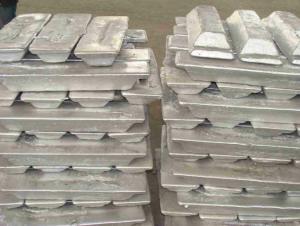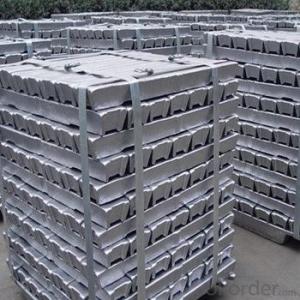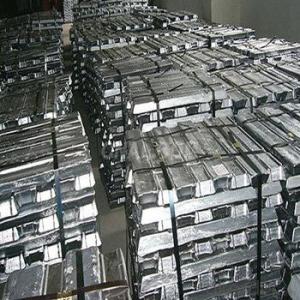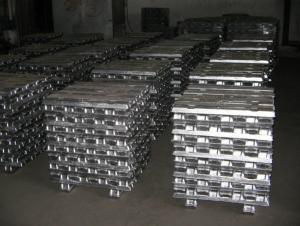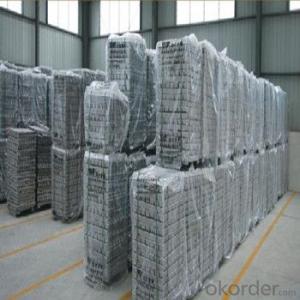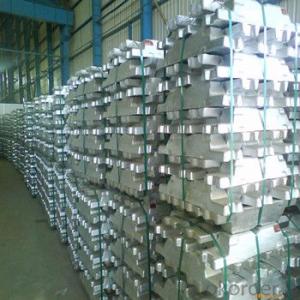Aluminum Ingots AA5052
- Loading Port:
- Shanghai
- Payment Terms:
- TT or LC
- Min Order Qty:
- 20 Tons m.t.
- Supply Capability:
- 1000 Sets Per Month m.t./month
OKorder Service Pledge
Quality Product, Order Online Tracking, Timely Delivery
OKorder Financial Service
Credit Rating, Credit Services, Credit Purchasing
You Might Also Like
1. Specifications of Aluminum Ingots AA5052
| Product Name | Aluminum Ingot |
| Chemical Composition | Al |
| Weight | 20/25kg |
| Al (Min) | 99%-99.9% |
| Appearance | silvery white |
| Advantages | easy control and operation, fast melting |
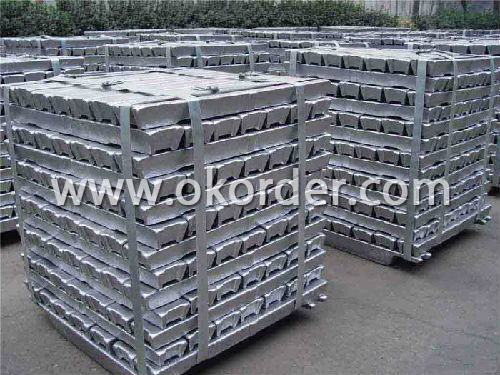
2. Usage/Application of Aluminum Ingots AA5052
A. mainly used for melting ingot
B. discontinuous melting with scrap
3.Packaging & Delivery of Aluminum Ingots AA5052
About 25Kg /Ingot, Packed in wooden case, Net weight 1000Kg/ Case, or as customer's requirements.
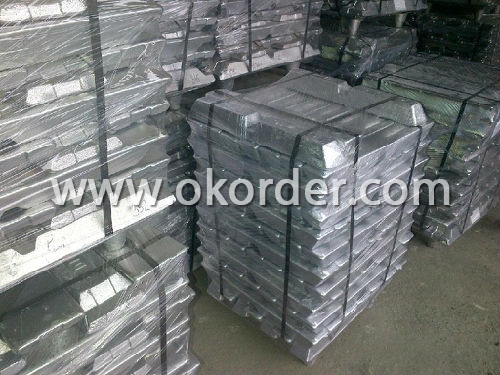
- Q:What are the main factors influencing the choice between aluminum ingots and aluminum slabs?
- There are several factors that can influence the choice between aluminum ingots and aluminum slabs. 1. Production process: The choice of ingots or slabs can depend on the production process involved. Ingots are typically preferred for casting and shaping purposes, as they can be easily melted and molded into desired forms. Slabs, on the other hand, are commonly used in rolling and extrusion processes, where they are passed through rollers to create thin sheets or extruded into various shapes. 2. Product requirements: The specific requirements of the end product can also influence the choice between ingots and slabs. If the final product requires a specific shape or thickness, slabs may be preferred as they can be directly processed into the desired dimensions. However, if the product requires a different form, such as casting into complex shapes, ingots may be more suitable. 3. Cost considerations: The cost of production can also play a significant role in the choice between ingots and slabs. Ingots are generally cheaper to produce as they require less processing and have fewer quality requirements. Slabs, on the other hand, may require additional processing steps such as rolling or extrusion, which can increase production costs. 4. Market demand: The demand for specific aluminum products in the market can also impact the choice between ingots and slabs. If there is a higher demand for products that can be derived from slabs, such as sheet metal or extruded profiles, then slabs would be preferred to meet the market needs efficiently. 5. Production capacity and resources: The available production capacity and resources of a manufacturer can also influence the choice. If a company has the necessary machinery and capabilities to process aluminum slabs efficiently, it may choose slabs over ingots to maximize its production capacity and resources. Overall, the choice between aluminum ingots and aluminum slabs depends on a combination of factors including production process, product requirements, cost considerations, market demand, and available resources. Manufacturers need to carefully evaluate these factors to make an informed decision that aligns with their production capabilities and market demands.
- Q:How is aluminium ingot made?
- Aluminum is the world's output and consumption of ferrous metals only next to steel. The density of aluminum is only about 2.7103g/cm3[1], about 1/3 of the density of steel, copper or brass. Because of its lightweight material, aluminum is commonly used in the manufacture of automobiles, trains, subways, ships, aircraft, rockets, ships and other land and air vehicles to reduce deadweight and increase loading capacity. Aluminum is also widely used in military industry.
- Q:What are the common defects found in aluminum ingots?
- There are several common defects that can be found in aluminum ingots. One of the most common defects is porosity, which refers to the presence of small voids or air pockets within the ingot. Porosity can occur due to improper casting techniques or insufficient degassing of the molten aluminum. This defect can weaken the overall structure of the ingot and reduce its mechanical properties. Another common defect is segregation, which occurs when there is an uneven distribution of alloying elements or impurities within the ingot. This can result in variations in the composition and properties of different sections of the ingot. Segregation can be caused by improper alloying or inadequate mixing of the molten aluminum. Cracking is another defect often found in aluminum ingots. This can occur during cooling or solidification of the ingot if there is rapid or uneven cooling, leading to thermal stress and cracking. Cracking can also be caused by excessive hydrogen content in the aluminum, which can promote the formation of internal cracks. In addition, surface defects such as dross, oxide films, and inclusions can be commonly found in aluminum ingots. Dross refers to the impurities and oxides that float on the surface of the molten aluminum, which can become trapped in the ingot during solidification. Oxide films can form on the surface of the ingot due to exposure to air or inadequate protection during casting. Inclusions, on the other hand, are foreign particles or non-metallic compounds that are trapped within the ingot during solidification. These defects can have a significant impact on the quality and performance of aluminum ingots. Therefore, it is crucial to employ proper casting techniques, control alloy composition, ensure adequate degassing, and implement effective quality control measures to minimize the occurrence of these defects.
- Q:Can aluminum ingots be used in 3D printing?
- Yes, aluminum ingots can be used in 3D printing. Aluminum is a commonly used material in additive manufacturing due to its lightweight, high strength, and excellent thermal conductivity. However, instead of directly using aluminum ingots, a process called powder bed fusion, specifically selective laser melting (SLM) or electron beam melting (EBM), is utilized. In this process, fine aluminum powder is spread in thin layers and selectively melted by a laser or electron beam, layer by layer, to create the desired 3D object. This allows for the production of complex geometries and precise parts with high strength and accuracy.
- Q:The difference between electrolytic aluminium, alumina and aluminium ingot
- Two, the production process is relatively speaking, the process of alumina production is more complex, the production of a ton of aluminum ingots require about two tons of alumina, the product must be expensive to produce aluminum ingots.
- Q:How much is a ton of aluminium ingots now?
- Futures: the Fed announced interest rate hike, the dollar frustrated, overnight aluminum rose $23 to $1884 / ton; Shanghai aluminum night plate affected by the outer disk, the strong side of the shock operation;
- Q:How are aluminum ingots inspected for quality?
- The quality of aluminum ingots is assessed through a comprehensive and methodical process. This process entails visual examination, dimensional measurements, and the utilization of different testing methods. To begin with, inspectors who have received training meticulously inspect the ingots to identify any surface defects such as cracks, dents, or impurities. Their close examination ensures that the ingots meet the necessary standards. Next, precise instruments like calipers or digital measuring devices are employed to measure the size and weight of the ingots. This involves checking the length, width, height, and weight of each ingot and comparing these measurements with the specified tolerances to ensure compliance. Furthermore, in addition to visual inspection and dimensional measurements, various testing methods are utilized to evaluate the mechanical properties and chemical composition of the aluminum ingots. These tests include hardness testing, tensile strength testing, impact testing, and spectroscopic analysis. Hardness testing gauges the ingot's resistance to indentation or deformation, providing insights into its strength. Tensile strength testing measures the maximum stress the ingot can endure before breaking. Impact testing evaluates the ingot's ability to absorb energy under sudden loading conditions. These tests aid in identifying any weaknesses or inconsistencies in the mechanical properties of the ingot. Moreover, spectroscopic analysis is employed to determine the chemical composition of the ingots. This analysis involves examining the elements present in the aluminum alloy and comparing them with the specified composition. It guarantees that the desired alloying elements are present in the correct proportions, ensuring the suitability of the ingots for specific applications. In conclusion, the evaluation of aluminum ingots for quality entails a combination of visual examination, dimensional measurements, and various testing methods. By adhering to these rigorous quality control procedures, manufacturers can ensure that the aluminum ingots delivered to customers meet the required standards and possess superior quality.
- Q:Are aluminum alloy ADC12 and aluminium ingot ADC12 the same?What's the difference? The price you see in Ali looks different
- One thing, Ali price was not allowed to say, according to the product quality, the price is certainly not the same
- Q:Can aluminum ingots be used in the production of jewelry?
- Indeed, the application of aluminum ingots in the production of jewelry is possible. Aluminum, being a versatile metal, lends itself easily to the molding and shaping required for various jewelry designs. With its lightweight nature, it ensures a comfortable wearing experience, while its inherent silver-like appearance can be further magnified through diverse surface finishes, including polishing or anodizing. Moreover, its hypoallergenic properties render it an appropriate choice for those individuals with sensitive skin. Although aluminum may not possess the same value as precious metals like gold or silver, it presents a more economical alternative for crafting jewelry and can be combined with other materials to yield distinctive and fashionable pieces.
- Q:How are aluminum ingots used in the production of electrical enclosures?
- Aluminum ingots play a crucial role in the production of electrical enclosures due to their unique characteristics and properties. These ingots are melted and then cast into specific shapes and sizes to create the main components of an electrical enclosure. Firstly, aluminum is highly desirable for electrical enclosures due to its excellent conductivity. It allows electrical currents to flow efficiently through the enclosure, ensuring proper functioning of the electronic devices inside. This conductivity helps in preventing any interference or disruption in the electrical circuit. Secondly, aluminum is known for its lightweight and corrosion-resistant properties. This makes it an ideal choice for electrical enclosures, as they need to be durable and resistant to environmental factors such as moisture, dust, and chemicals. The corrosion resistance of aluminum ensures that the enclosure remains intact and functional for a longer period of time, even in harsh conditions. Furthermore, aluminum ingots can be easily machined and fabricated into various shapes, enabling manufacturers to design enclosures that meet specific requirements. The ingots are melted and poured into molds to create the desired shape, allowing for customization and flexibility in the production process. This versatility is particularly important in the electrical industry, where enclosures need to accommodate different types of equipment and wiring configurations. In addition, aluminum ingots are often preferred for their thermal conductivity. Electrical enclosures generate heat due to the operation of the enclosed devices. Aluminum efficiently dissipates this heat, preventing overheating and ensuring the safety and longevity of the electronic components. Overall, aluminum ingots are extensively used in the production of electrical enclosures due to their conductivity, lightweight, corrosion resistance, ease of fabrication, and thermal conductivity. These qualities make aluminum an excellent material choice for creating enclosures that protect and enhance the performance of electrical equipment.
We are a well-known enterprise specializing in the production and sales of aluminum sheets and coils.
Since the establishment of us, we have been devoted to setting up a good CIS and completely implementing ISO9001 quality management system.
1. Manufacturer Overview |
|
|---|---|
| Location | Henan,China |
| Year Established | 1993 |
| Annual Output Value | Above US$200 Million |
| Main Markets | Mid East;Eastern Europe;North America |
| Company Certifications | ISO 9001:2000;ISO 14001:2004;OHSAS 18001 |
2. Manufacturer Certificates |
|
|---|---|
| a) Certification Name | |
| Range | |
| Reference | |
| Validity Period | |
3. Manufacturer Capability |
|
|---|---|
| a)Trade Capacity | |
| Nearest Port | Shanghai |
| Export Percentage | 30%-50% |
| No.of Employees in Trade Department | 21-50 People |
| Language Spoken: | English;Chinese |
| b)Factory Information | |
| Factory Size: | Above 100,000 square meters |
| No. of Production Lines | Above 10 |
| Contract Manufacturing | OEM Service Offered;Design Service Offered |
| Product Price Range | Average |
Send your message to us
Aluminum Ingots AA5052
- Loading Port:
- Shanghai
- Payment Terms:
- TT or LC
- Min Order Qty:
- 20 Tons m.t.
- Supply Capability:
- 1000 Sets Per Month m.t./month
OKorder Service Pledge
Quality Product, Order Online Tracking, Timely Delivery
OKorder Financial Service
Credit Rating, Credit Services, Credit Purchasing
Similar products
New products
Hot products
Related keywords
